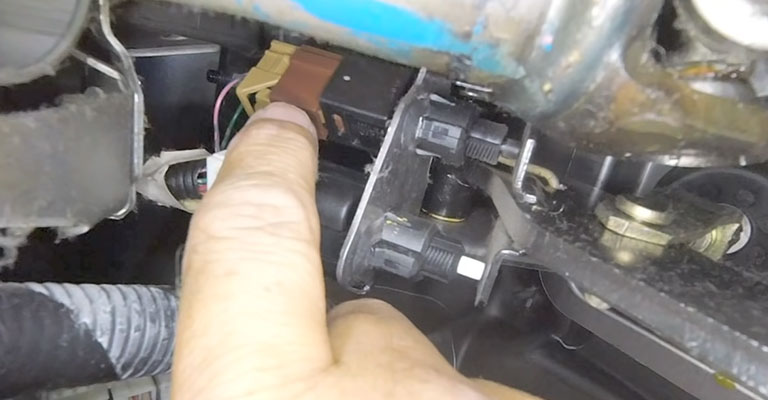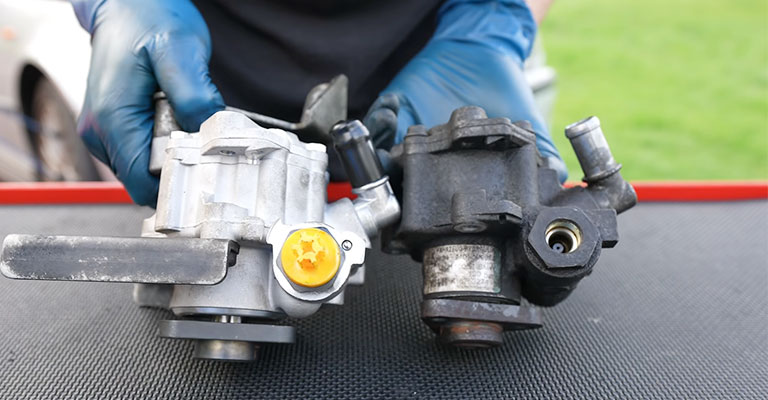Unlike many old predecessors, Honda CRV comes with an electric parking brake having an automatic brake hold.
It’s pretty handy as you no longer need to press the pedal or lower the brake handles manually. I meet folks who often report issues with their CRV’s electric parking brake.
The issues include the Electric Brake Problem error message, continuous brake light flashing, the brake system lit up in yellow, or the parking brake can’t be engaged or disengaged correctly.
The common causes behind these issues are:
- Bad parking brake switch.
- A dying or low-voltage battery.
- Loose wiring.
- Bad servo motors.
Here I’ll help you have a better look at these issues and find all the possible solutions for your Honda CRV electric parking brake problem. Let’s start!

Taking A Closer Look: Electric Parking Brake Problem in A Honda CRV Explained
The electric parking brake in Honda CRV is electronically controlled, which the driver can activate by lifting the switch and release by pushing the button down.
It’s a replacement for the older emergency brakes that needed you to press the traditional foot pedal or lower the hand lever.
An electric parking brake problem in the Honda CRV means a component isn’t functioning correctly; hence, it’s hard to engage or disengage the brake or even start the vehicle.
The major components of the parking brake system in CRV include the button/switch, caliper & servo motors, and wiring.
If any of these go bad, you’re most likely to see an Electric Parking Brake Problem error message on the dash or find it hard to engage or disengage the brake.
What to Do About Your CR-V’s “Electric Parking Brake Problem” Warning Message?
In some cases, you do not need to bring your SUV to a mechanic or have it disassembled in order to resolve the parking brake problem.
Furthermore, before you check the parts, try troubleshooting the electric parking brake problem by resetting your vehicle’s system.
It’ll ensure the parking brake problem isn’t due to the automatic activation. Here’s what you’ve to do to reset the system:
- Use the brake pedal to bring your vehicle to a stop
- Shift the gear to Neutral
- Turn off the vehicle ignition and press the parking brake switch down for 2 seconds
The automatic activation should be suspended, and you can restart your vehicle to see whether the issue is fixed. If the problem persists, you’ve to check for malfunctioning in any of the EPB parts and fix it.
Honda CRV Electric Parking Brake Problem – Causes and Fix
You’re seeing the parking brake problem may be because of a bad parking brake switch, a dying battery or power supply issue, a wiring problem, or bad servo motors issue. Take a better look at these causes below and how you could fix them.
1. A Bad Parking Brake Switch

A bad parking switch or button commonly causes the electric parking brake error message in Honda CRV.
Over time, as you use the switch, dirt, debris, or grime can trigger it in the center console. It could also malfunction if you accidentally spill any drink on it.
A bad switch will show different symptoms like it’ll cause your parking brake light to stay illuminated.
If you suspect a failing switch, you can put the vehicle under-diagnosis, and it’ll most likely show the DTC C1120-14, indicating a faulty parking brake switch.
Fix
To fix a faulty parking brake switch in your Honda CRV, you’ll need a new switch. You can buy the part (the complete switch assembly) from the dealer or online, which should cost around $70 to $90.
The installation could come with a hefty cost of $60, but you can save this money if you install it yourself. Here I’ll tell you how to install a new parking brake switch on your Honda CRV and save some bucks.
- Ensure the car is turned off and put the key fob out of range.
- You should see a trim piece surrounding the gear selector lever. Pry up from the bottom and wiggle it to find it coming off.
- Now you’ve to take the climate control panel off. Unsnap it with a bit of force at both the left and right end.
- After you’ve wiggled both the pieces, the trim, and the control panel, you can now access the wiring harness underneath the parking brake. Once you’ve found it, simply disconnect it.
- Now you’ve to take the old switch assembly off. Look for the two Philips screws holding the assembly in place and unscrew them to remove them.
- Now reverse the steps. Firstly, take your new switch assembly and screw it to set it up. Connect the wiring harness and put the trim and climate control panel back in place.
- Check out if the parking engages and disengages properly. Also, see if the error message on the dash has disappeared. If everything’s okay, you’ve saved a half-hour labor cost!
2. A Dead/Drying Battery or A Power Supply Issue

A failed power supply to your vehicle’s braking system will prompt the Electric Parking Brake Problem message. It could happen if you’ve got a dying battery or a problem in the power supply unit.
A battery with a low power state can cause different system malfunctions when you try to start the engine or turn the ignition on. The brake pedal may also kick back when the electric parking brakes do a reset.
Check the power supply unit for any loose connections. Use a multimeter to check the DC reading. It can also help you check voltage readings to see whether the battery voltage is around 10 to 12V.
If you see any abnormal or no reading for either of the two components, you’ll know who’s causing the problem.
Fix
If the low-state battery is causing the problem, make sure it’s fully charged. When you start your CRV, drive it for around 20 to 30 minutes to keep the engine on and allow the battery to charge fully.
If your battery isn’t charging or is dead, you must immediately replace it as the electrically controlled components, including your vehicle’s parking brake, need to draw power from it.
In the case of the power supply unit, fix any loose connection. If there’s no visible problem with the unit, you need to get it inspected by a mechanic to see whether the power supply unit has gone bad. If it has, you have to buy a new one.
If the factory warranty is left, take it to the dealer for evaluation and get the battery or power supply unit repaired or replaced under the factory warranty.
Installation isn’t a concern since auto parts stores generally provide free installations. You can avail of it from the store you buy the parts from.
3. Wiring Issues

If your CRV’s electric parking brake system has a loose or bad connection in the wiring, it’ll cause the parking brake problem. It could include the wiring in the console’s center and any clip that connects to other components like the servo motor.
Loose wiring can create miscommunication between the EPB module and switches. Corroded cables or worn-out connectors can also cause the parking brake problem.
Fix
Since wiring issues are hard to inspect, it’s better to pay a visit to a mechanic instead of trying to fix it on your own.
4. Bad or Worn Out Servo Motor

The parking brake system of the Honda CRV comes with servo motors on the rotors. When the brake is applied, they lock the wheels.
Older vehicles with mechanical parking brakes use cables, but modern vehicles use servo motors to control the parking brake.
Since it’s a key component in the EPB of your Honda CRV, a bad or worn-out servo motor may show the Electric Parking Brake Problem message.
Fix
Although the DIY replacement of servo motors is possible, I won’t recommend you to do that, considering its complication. So you better take your Honda CRV to a professional mechanic to get the servo motors replaced.
FAQs
I’ve answered more queries regarding the Honda CRV electric parking brake problem here. Check them out.
1. How do you release a stuck electric parking brake?
Your electric parking brake may have stuck due to dirt, grimes, or another buildup. Set and release the brake multiple times, rock the vehicle back and forth, or manually get under it to pull its cables to knock the brake free.
2. How do you turn off the electric parking in the Honda CRV?
Since automatic activation of the electric parking brake can cause troubles, you may need to deactivate it in your Honda CRV.
To do that, start your Honda, then lift the parking brake switch without pressing on the brake pedal, and hold the brake switch until you hear a loud beep.
After that, you can release the parking brake switch. The beep indicates the deactivation of the automatic parking brake.
Problems With Your CR-V’s brakes? It’s Not Just You
It’s not an isolated case that your CR-V’s electric parking brake is malfunctioning. CR-Vs of the fifth generation have also experienced this problem in other model years.
There are some that have worse consequences than simply appearing on the dashboard with a warning message.
About 1.7 million 2017-2019 CR-Vs and Accords have been investigated by the National Highway Traffic Safety Administration (NHTSA) for random brake problems.
There were 278 complaints of unnecessary braking submitted to the NHTSA during the course of the investigation, and six of these incidents culminated in collisions.
The emergency brakes of affected models have been reported to engage unexpectedly even when they are not required. As of yet, Honda has not issued a recall regarding this issue.
Final Words
You can know your Honda CRV electric parking brake problem in two ways. You’ll most commonly see the error message on the dashboard or may also notice the parking brake light staying on uninterruptedly.
You could also face trouble engaging or disengaging the parking brake correctly; in some cases, your vehicle may not start. Honda accord or other models might get this problem.
First, try resetting the system, as it should solve temporary malfunctions or if the issues are caused by automatic activation.
If it doesn’t address the issue, inspect the major components of the EPB, such as the button, battery voltage, power supply, wiring, and servo motor, as discussed in the article.
Some you could solve on your own, while other issues will require you to visit a mechanic.

Leave a Reply